#sauropterygian
Text

Patreon request for rome.and.stuff (Instagram), and my first plesiosaur (well, first since I was like… 10)
Pliosaurus funkei!
Pliosaurs were a family of plesiosaurs that eventually lost their stereotypical long-necked, small-headed body plan. Resembling the mosasaurs that would come much later, pliosaurs had short necks with large, strong jaws, and fed on fish, cephalopods, and marine reptiles. The type genus, Pliosaurus, contains at least 6 species. The first and type species, P. brachydeirus, was described and named by Sir Richard Owen in 1841.
Between 2004 and 2012, a new species of Pliosaurus was in the process of being uncovered. Before it was formally described or even named, news of this giant sea monster escaped into the general media and it was dubbed “Predator X”.
This Predator X prompted a media frenzy… there were articles estimating its size based on the fragments found so far, a 2009 television special on the History channel, and a segment in the 2011 BBC documentary series “Planet Dinosaur.”
Predator X was reportedly the “most fearsome animal ever to swim in the oceans!”
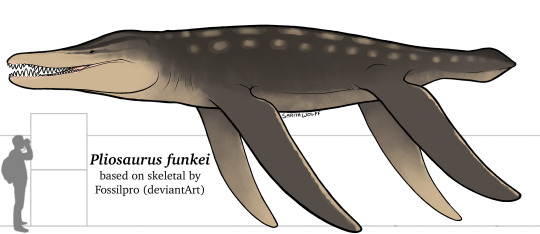
When Pliosaurus funkei was finally formally described and named in 2012, it was found to be a bit smaller than the giant 15 meter long estimate being thrown around. However, it was still a very large animal, around 10–12 m (33–39 ft) long with a 2.0–2.5 m (6.6–8.2 ft) long skull. It also had very long flippers, probably to aid in maneuverability and speed. Analysis of Pliosaurus funkei’s skeleton show that it likely used its front flippers to cruise, only using its back flippers for quick bursts of speed when pursuing prey. Analysis of its brain case shows that its brain was proportional to that of a modern great white shark. So while it didn’t quite beat the Late Cretaceous 12–15.8 meter (39–52 ft) long mosasaur Tylosaurus, the Early Miocene to Late Pliocene 10.5-20.3 meter (34-67 ft) long shark Otodus megalodon, or even the modern day 11-16 meter (36-52 ft) long Physeter macrocephalus (Sperm Whale), it was still no doubt the apex predator of its time and environment.
Pliosaurus funkei lived in the last era of the Late Jurassic in the icy waters of Norway. Found in the Slottsmøya Member of the Agardhfjellet Formation, it would have lived in a cold, shallow sea rife with methane seeps. These methane seeps supported a high amount of diversity, and the Slottsmøya was teeming with ammonites, bivalves, gastropods, brachiopods, tubeworms, echinoderms, cold water sponges, and more. Many icthyosaurs and plesiosaurs would have enjoyed feeding on the plentiful invertebrates here, as well as each other. Pliosaurus funkei would have likely fed on other plesiosaurs like Colymbosaurus, Djupedalia, Ophthalmothule, and Spitrasaurus, as well as icthyosaurs like Cryopterygius, Undorosaurus, Arthropterygius, Nannopterygius, and Brachypterygius.
#my art#SaritaDrawsPalaeo#Pliosaurus funkei#Pliosaurus#pliosaur#predator x#plesiosaurs#sauropterygians#reptiles
13 notes
·
View notes
Note
How closely related are marine reptiles like plesiosaurs and ichthyosaurs to dinosaurs? I know mosasaurs are more related to lizards but wasn’t sure about the other famous marine reptiles.
I know they’re not dinosaurs obviously but I was curious if it was a case of close relatives like pterosaurs. They don’t seem very close so I’m assuming not very related at all, and they’re just grouped in since they’re contemporary.
Soooo we don't know *how* close they are because their evolutionary relationships are in flux, but they aren't super close. Ichthyosaurs may not even be in crown-reptiles - ie, they aren't more closely related to dinosaurs or crocs or lizards, but equally closely related to all of them, falling outside the group that contains living reptiles. Or they're grouped with the other marine reptiles, called Sauropterygians. Sauropterygians includes plesiosaurs, pliosaurs, and a bunch of Triassic Weirdos. For a while, we thought they were closer to living turtles than anything else - so in Pan-Testudines. But that's come into question, especially now that we know turtles are part of the crocodile-bird tree (Archosauromorphs) than the lizard-snake tree. However, recent studies have indicated they may be Archosauromorphs.
So the short version of all that is: they may be closer to dinosaurs than to lizards, but they also might just be equally closely related to all living reptiles. Or maybe they're closer to turtles than to lizards or dinosaurs. Who knows. Science is fun!
28 notes
·
View notes
Text

Something that occurred to me on a discussion regarding bowhead whales and sauropterygians, it came to my mind to me to create the ultimate Aristonectid descendant, these pull out the extreme of filter feeding adaptation of their group turning their lower jaw into a specialized large set of baleen-like structures growing out of the gum, with a huge sloth that holds the keel of the palate so it push the water while it catch the food; they extremely developed their heads, coming out of a short necked and bigger head trend that started in the Paleogene, their heads now forms half of the body length, the upper teeth have become useless for feeding so they preserved them as a sort of defense helping them while ramming towards adversaries.
283 notes
·
View notes
Text
Life in the Early Triassic

(first row: Sclerosaurus, Lystrosaurus; second row: Hupehsuchus, Triadobatrachus, Cartorhynchus; thrid row: Rebellatrix, Atopodentatus; fourth row: Aphaneramma, Erythrosuchus)
Lystrosaurus - Julio Lacerda
Erythrosuchus - Mark Witton
Rebellatrix - Michael Skrepnick
Aphaneramma - Gabriel Ugueto
Cartorhynchus, Hupehsuchus, Atopodentatus - Nobu Tamura
Triadobatrachus - Alexey Malitskiy
Sclerosaurus - Wikimedia
We‘ve reached the Triassic period and with it the Mesozoic Era, the Age of Reptiles! Right now (about 250 million years ago), the reptiles are not dominating yet - in fact no one really was doing too well, as the Early Triassic was mostly a recovery period with low diversity after the most devastating mass extinction of all time, The Great Dying, at the end of the Permian.
The one exception to this is Lystrosaurus. The pig-sized herbivores somehow made it through the mass extinction mostly unscathed and in a now barren world they re-diversified, took up empty niches and became the most common vertebrate in many areas. It is not entirely clear why they survived. Maybe it was hibernation or burrowing that gave them some kind of protection from the worst parts of The Great Dying, maybe they were just lucky. Whatever it was, these prehistoric cockroaches marked one of the last big hurrahs of the synapsids (our own linage), before they went into hiding and lived their lifes as rodent size critters in the shadows of the reptiles for the following 200 million years or so.
The synapsids were the stars of the Permian, but only three groups of them made it into the Triassic: The carnivorous therocephalians and the herbivorous dicynodonts like Lystrosaurus with bulky bodies, mostly toothless beaks and tusk-like canines. They both went extinct during the Triassic. A third group, the cynodonts, survived much longer and will eventually include all modern mammals, from the tiniest bats to the biggest whales. But right now all of that is just some distant future.
Right now, at the beginning of the Triassic, a lot of other groups hurry to fill empty spaces. Several groups of reptiles decided that, after their ancestors once spent a lot of time and effort to evolve a terrestrial lifestyle, they want to return to the oceans. This included early cousins of the ichthyosaurs (those dolphin-shaped marine reptiles that lived alongside the dinosaurs) like Cartorhynchus and very basal sauropterygians. The most famous member of that group are the Loch-Ness-Monster-looking plesiosaurs, but one early member was the strange Atopodentatus. They possibly used their weird mouths to eat algae, making them one of the earliest herbivorous marine reptiles.
On land, the most interesting development might be the rise of the archosaurs and their close relatives. Over the span of the Mesozoic, the age of reptiles, they became the dominate group of life including many fan-favorites: The giant dinosaurs, the flying pterosaurs, the birds we have today and the wide variety of crocs, both past and present. At the beginning of the Triassic, they are just starting out, but 5 m long predators like the big-headed Erythrosuchus (although they are technically not quite archosaurs), already give a glimpse into their future.
22 notes
·
View notes
Note
So watching PP yesterday was the first time I learned that mosasaurs were squamates (possibly literally lizards? I wasn't clear). Is that also true of other marine reptiles like plesiosaurs as well? I somehow always thought they were an entirely separate order of Reptilia.
Yep, being squamates means that mosasaurs are literally lizards! There's a bit of disagreement about where they sit in the lizard family tree but they're usually placed around the varanid/snake area, some researchers have explicitly classified them as varanids but that's questionable.
On the other hand, other marine reptiles are from much older lineages unrelated to lizards that are now totally extinct. Plesiosaurs and pliosaurs come from an ancient group of reptiles called Sauropterygians ("reptile flippers") that evolved in the early Triassic, and also includes weird Triassic groups such as nothosaurs and placodonts!
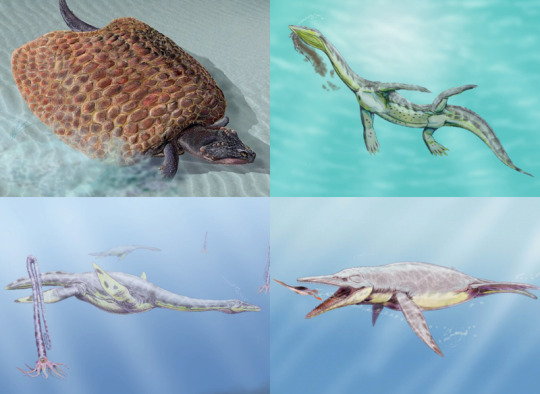
All the major sauropterygian groups! Including Parahenodus (a placodont), Ceresiosaurus (a nothosaur), Aristonectes (a plesiosaur) and Brachauchenius (a pliosaurid plesiosaur). Via Wikimedia Commons.
Ichthyosaurs are in their own weird little group from the early Triassic as well, called ichthyosaurimorphs! One of the earliest representatives of the group is called Cartorhynchus, which probably looks like this:
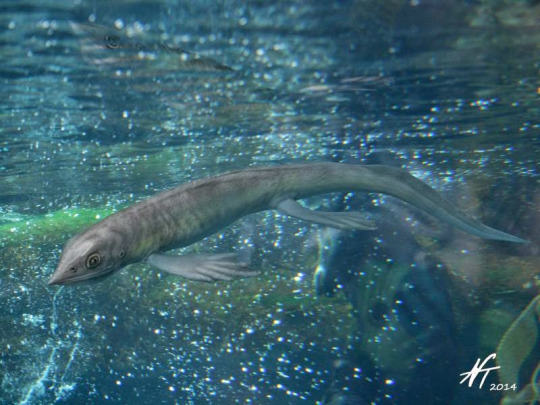
(Art by Nobu Tamura)
In fact, the only other group of marine reptiles aside from mosasaurs that belong to a group of reptiles that are alive today are crocodiles! From the Early Jurassic to Early Cretaceous, a group of marine crocodylomorphs called Thalattosuchians lived in the oceans all around the globe! They were actually just a well adapted to marine life as mosasaurs were, even evolving tail flukes!

(art by Dmitri Bogdanov)
#paleontology#mosasaurs#plesiosaurs#ichthyosaurs#thalattosuchians#marine reptiles#paleoart#palaeoblr#fossils#prehistoric planet
344 notes
·
View notes
Text
March Madness Day 2!
Mosasaurus
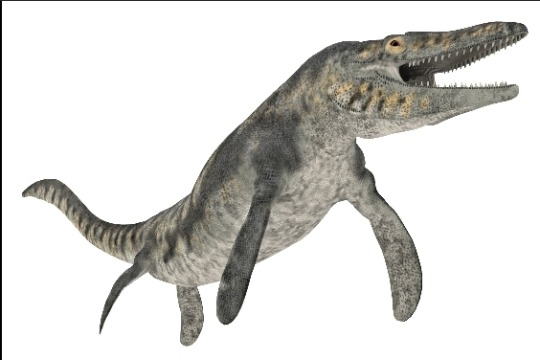
Or Elasmosaurus

So, why aren't yhese guys considered dinosaurs? Here's a few reasons:
1.) Both are marine organisms. Dinosaurs (at least non-avian) are terrestrial.
2.) Mosasaurus is a aquamate. Basically, a giant sea lizard.

Dinosaurs are archosaurs.

Elasmosaurus is a sauropterygian like Nothosaurus.

Which one do you want to keep in the competition? REBLOG for MOSASAURUS.
LIKE for ELASMOSAURUS.
Voting open until tier 2 begins (March 16).
5 notes
·
View notes
Text
Curated List of My Tumblr Posts on Paleontology, Classification, Doraemon, etc.
I don’t currently take asks on this blog, but over the years I’ve accumulated a good amount of material on here that I essentially haven’t posted anywhere else. Given that finding old posts on Tumblr can be a difficult and arduous task, I’ve decided to assemble a curated selection of links to my posts that I think are of particular interest (whether on a general or personal level). These are often posts that have been especially popular, posts that I especially enjoyed writing, or both. Yes, I’m including the Doraemon reviews. 😛 For ease of access, I have also replicated this list on a page on this blog, which I will try to keep updated as I deem necessary.
Paleontology Resources
What are some good introductory resources for dinosaur paleontology?
What are some good YouTube channels about paleontology? (needs updating)
Some ways to access paywalled scientific papers (and why I won’t repost published phylogenetic figures on @new-dinosaurs)
What should one major in college to get into paleontology?
How do I make phylogenetic diagrams?
How to subscribe to the Dinosaur Mailing List
Specific Dinosaur Questions
How flexible are dinosaur tails?
What types of dinosaurs have feathers?
Wasn’t there a study showing that feathers were not an ancestral trait of dinosaurs?
How reliable are melanosomes for reconstructing the colors of extinct dinosaurs?
Why does paleoart of feathered dinosaurs tend to show the tip of snout unfeathered?
Is it true that non-avian dinosaurs couldn’t roar?
Which dinosaurian herbivores are foregut fermenters and which ones are hindgut fermenters?
When did dinosaurs evolve hollow bones?
Could sauropods swim?
Can any theropods pronate their hands? (And how about other reptiles?)
Were giant maniraptoriforms likely to have been featherless?
Did flightless non-avialan pennaraptorans have feather barbules?
Would Microraptor and Anchiornis have had trouble walking due to their large hindlimb feathers?
What do we know about the social and reproductive behaviors of dromaeosaurids?
Did bird ancestors evolve flight from the ground up or trees down? How might flight have evolved from the ground up? Do we have extant analogues for such a process?
How do we know birds are actually dinosaurs, and that we haven’t been misled by convergent evolution?
Why do birds have backward-pointing dewclaws?
What is the most likely phylogeny of modern birds?
Are eider ducks the fastest animals in the world?
Were there penguins in the Cretaceous?
Why do bateleur eagles have short tail feathers?
Do all owls have asymmetrical ears?
Are falcons closely related to parrots?
How many times did poison evolve in songbirds?
Taxonomy, Nomenclature, and Phylogenetics
How do you pluralize genus/species names?
What is the phylogenetic species concept?
What is wrong with ranked/Linnaean taxonomy?
If birds are reptiles, shouldn’t tetrapods be considered fish?
Should we avoid calling birds dinosaurs because they were not traditionally called dinosaurs?
How is phylogenetic nomenclature reconciled with the fact that species must have evolved from other species?
What is a synapomorphy and how do we identify one?
How often do morphological and molecular phylogenetics agree?
General/Other Biology
Should the study of birds be included under herpetology?
Why is monogamy more common in birds than in mammals?
We don’t know what ichthyosaurs and sauropterygians are (needs updating)
How do reptiles drink?
How to identify a rodent skull
Why do mammals have ear flaps?
Could a mammal evolve as many neck vertebrae as a bird?
How can you tell the position of an animal’s ears by looking at its skull?
What is the difference between mesothermy and endothermy?
Why has the "Handicap Principle” been disputed?
Does any organic material remain in fossils?
Does it worry me that paleontologists will run out of fossils to discover?
What do I think about using humor in scientific outreach?
Just for Fun
Meme about fossil bird books
Fusion is a cheap tactic to make weak reptiles stronger
Meme about horses in geology
What are some works of paleo-fiction that I enjoy? (needs updating)
What are some webcomics about extinct animals that I enjoy? (needs updating)
List of science-themed music artists (needs updating)
Phylogeny (“Under the Sea” parody)
We don’t talk about Spino
Are there non-talking horses in Equestria (from My Little Pony: Friendship is Magic)?
Hilda and the nature of revelations
Doraemon
Movie review: Nobita’s Dinosaur (1980) and Nobita’s Dinosaur (2006)
Movie review: The Records of Nobita, Spaceblazer (1981) and The New Record of Nobita’s Spaceblazer (2009)
Movie review: Nobita and the Haunts of Evil (1982) and New Nobita’s Great Demon (2014)
Movie review: Nobita and the Castle of the Undersea Devil (1983)
Movie review: Nobita’s Great Adventure into the Underworld (1984) and Nobita’s New Great Adventure into the Underworld (2007)
Movie review: Nobita’s Little Star Wars (1985) and Nobita’s Little Star Wars 2021 (2022)
Movie review: Nobita and the Steel Troops (1986) and Nobita and the New Steel Troops (2011)
Movie review: Nobita and the Knights on Dinosaurs (1987)
Movie review: The Record of Nobita’s Parallel Visit to the West (1988)
Movie review: Nobita and the Birth of Japan (1989) and Nobita and the Birth of Japan (2016)
Movie review: Nobita and the Animal Planet (1990)
Movie review: Nobita’s Dorabian Nights (1991)
Movie review: Nobita and the Kingdom of Clouds (1992)
Movie review: Nobita and the Tin Labyrinth (1993)
Movie review: Nobita’s Three Visionary Swordsmen (1994)
Movie review: Nobita’s Diary on the Creation of the World (1995)
Movie review: Nobita and the Galaxy Super-express (1996)
Movie review: Nobita and the Spiral City (1997)
Movie review: Nobita’s Great Adventure in the South Seas (1998)
Movie review: Nobita Drifts in the Universe (1999)
Movie review: Nobita and the Legend of the Sun King (2000)
Movie review: Nobita and the Winged Braves (2001)
Movie review: Nobita in the Robot Kingdom (2002)
Movie review: Nobita and the Windmasters (2003)
Movie review: Nobita in the Wan-Nyan Spacetime Odyssey (2004)
Movie review: Nobita and the Green Giant Legend (2008)
Movie review: Nobita’s Great Battle of the Mermaid King (2010)
Movie review: Nobita and the Island of Miracles (2012)
Movie review: Nobita’s Secret Gadget Museum (2013)
Movie review: Stand by Me Doraemon (2014)
Movie review: Nobita’s Space Heroes (2015)
Movie review: Nobita’s Great Adventure in the Antarctic Kachi Kochi (2017)
Movie review: Nobita’s Treasure Island (2018)
Movie review: Nobita’s Chronicle of the Moon Exploration (2019)
Movie review: Nobita’s New Dinosaur (2020)
Movie review: Stand by Me Doraemon 2 (2020)
Ranking the Doraemon movies (1980–2022)
Where to find Doraemon in English
20 notes
·
View notes
Photo

Alt-Triassic crossbilled sauropterygian via Midjourney 5.1.
11 notes
·
View notes
Text

DINOVEMBER DAY 10: 240MYA, ANISIAN STAGE; ITALY
In the shallow seas of Northern Italy, a Tanystropheus and a Besanosaurus swim alongside eachother. The Tanystropheus is cautious; in the water, his companion has the advantage. He would be in by serious danger if the Besanosaurus was hungry, but fortunately for him, she has just fed and has no interest in chasing after him. For now he will hurry back to the shore, leaving her to patrol the ocean. These two strange animals are both reptiles, and they are both exemplary of the reptiles' success in the Triassic. Reptiles are everywhere: in the seas, on the shore, in the trees, digging through the soil and charging across the sands. The synapsids still hold roles on this world, but the dicynodonts are restricted to be only the largest grazers, and no cynodont is bigger than a modern badger. They are relics of a bygone age, and by the end of the Triassic, most of them will be gone.
Of the reptiles that have evolved, some groups are separating themselves from the pack. One of these groups is the ichthyosaurs, a group of oceangoing reptiles that have taken advantage of the coral reefs that have re-emerged after the devastation of The Great Dying. Besanosaurus is a typical Triassic ichthyosaur, with her sleek 8m long body ending in a paddle like tail to propel herself through the water, guided by the 4 flippers that have evolved from the arms and legs of her ancestors. She is a fast moving apex predator, but other ichthyosaurs like Shastasaurus have become 80 tonne leviathans drifting through the open oceans. Another group of animals called the sauropterygians are also making moves towards the water, with the seal-like Nothosaurus being found on beaches across Europe. One day they too will lose their land capabilities, giving rise to the long necked plesiosaurs.
On land, a group called the archosaurs have risen to power, helped by their ability to save water when they excrete, making them better suited to the vast Triassic deserts. Tanystropheus is closely related to the archosaurs, and has taken advantage of the recovering seas also; he is a fisher, using a neck twice as long as his body to grab fish from the water while his feet stay planted on the shore. He is also an adept swimmer, though not so much that he could outspeed a hungry shark or ichthyosaur. His archosaurian cousins have produced a variety of forms, fast and slow, predator and prey, but one little archosaur, far away at the other end of Pangea, has just become the first member of a group of reptiles that will surpass all others, push what is physically possible for a land animal and rule the world without question: the dinosaurs.
#dinovember 2022#dinovember#anthems art#anthem posts#tanystropheus#besanosaurus#ichthyosaur#triassic
17 notes
·
View notes
Photo

Is an extinct genus of sauropterygian reptile from the Triassic period, approximately 240–210 million years ago, with fossils being distributed from North Africa and Europe to China. It is the best known member of the nothosaur order. Nothosaurus was a semi-oceanic animal which probably had a lifestyle similar to that of today's seals. It was about 4 metres (13 ft), with long, webbed toes and possibly a fin on its tail. However, some species such as N. zhangi and N. giganteus were larger, up to 5–7 metres (16–23 ft). When swimming, Nothosaurus would use its tail, legs, and webbed feet to propel and steer it through the water. The skull was broad and flat, with long jaws, lined with needle teeth, it probably caught fish and other marine creatures. Trackways attributed, partly by process of elimination, to a nothosaur, that were reported from Yunnan, China in June 2014, were interpreted as the paddle impressions left as the animals dug into soft seabed with rowing motions of their paddles, churning up hidden benthic creatures that they snapped up. Once caught, few animals would be able to shake themselves free from the mouth of Nothosaurus. In many respects its body structure resembled that of the much later plesiosaurs, but it was not as well adapted to an aquatic environment. It is thought that one branch of the nothosaurs may have evolved into pliosaurs such as Liopleurodon, a short-necked plesiosaur that grew up to 6.4 metres (21 ft), and the long-necked Cryptoclidus, a fish eater with a neck as long as 1.3 metres (4.3 ft).
Carnivore
Nothosaurus (c) Jurassic World Camp Cretaceous
Art (c) reneg661
1 note
·
View note
Photo

Pencil portrait_Liopleurodon.
Pencils, 2022.
References: Dan Folkes.
150 notes
·
View notes
Text
reptiles are the only TRUE genders
all of these clades can be found on the wikipedias
#trans#nonbinary#reptiles#birds#dinosaurs#prehistoric life#genderqueer#this post was made by a nonbinary intersex individual plz just go along with the joke#poll
420 notes
·
View notes
Text
Spectember D25: Ontogenetic niche shifts

Earth has recovered from a mass extinction just about 30 million years ago which would correspond to the time of the Oligocene, this version of earth happened the mass extinction of the K/Pg was delayed, so instead of ending in 66 million years ago cretaceous continued for other 30 million years until the asteroid struck down, ending the Mesozoic and so starting a new period of history of life, the delay of this mass extinction changed some aspects of evolutionary development of many groups, mammals did not became the only dominant clade in this time, many reptiles survivors have also took over, and with the short span of time that has passed to our modern times, the fauna amalgamation is a sort of reminiscence of the Eocene and even the Triassic, but cooler as the planet faced the glacial ages up to the Pleistocene.
In the ocean marine mammals are a thing of course, but they aren’t alone, Choristodere and crocodiles are also common if not predominant in the coasts and freshwater regions by a large amount, choristoderes in fact are coming in a path convergent to sauropterygians now resembling those to a big degree, with varied short body and long necked forms, predatory forms similarly to nothosaurs and very long finned forms that move across the open ocean, they have been very versatile to deal with the subsequent cooling of earth of the last 20 million years, and remain at top even with the new wave of mammals to take over the temperate and cold regions.
Among these, there are the largest coastal predators of the north hemisphere, a fully aquatic species that would look like an imitation of the Mesozoic pliosaurs, along them there are gracile fish eater forms that looks more kind to a plesiosaur, their jaws are narrower and their necks and flippers are longer, but this is no more like the juvenile of this same giant.
The Mocker Retroleviathan is a descendant of smaller choristoderes that ventured into the oceans million years before the mass extinction that already established through the extended later cretaceous thanks to the minor extinction events caused by the ecological transitions of those million years, and after the cataclysm the empty ocean left behind by the large reptiles were early claimed by these reptiles in a short time, becoming megafauna and spreading across the oceans.
The Retroleviathan is the most formidable of these, reaching up to 7 meters and weighting 2 tons, it normally feeds on different large animals including other large choristoderes, some of the piscivorous pelagic crocodilians and the increasingly large para-cetos which are derived multies that adopted fully an aquatic lifestyle resembling an archeocete with a sirenian head but with unique dentitions. They are viviparous, a female can gestate more than 10 offspring which at birth are quite independent of their parents, only being sheltered in the nearby of the territory of the adults until they reach maturity.
25 notes
·
View notes
Text

Paleo Huevember day 13 - Atopodentatus unicus
25 notes
·
View notes
Text
I'm officially convinced that the morphologists have it w/r/t turtles and that turtles are diapsids, crown group sister to Lepidosaurs, SIMPLY so that I can support Pantestudinata containing sauropterygians.
Plesiosaurs are (stem) turtles if you believe hard enough and wish with all your heart
#paleoblr#palaeoblr#biology#turtles#sauropterygian#phylogeny#this is my personal opinion and dont care what the dna people tell you it makes sense and is better. trust me
3 notes
·
View notes
Text
Nothosaurus
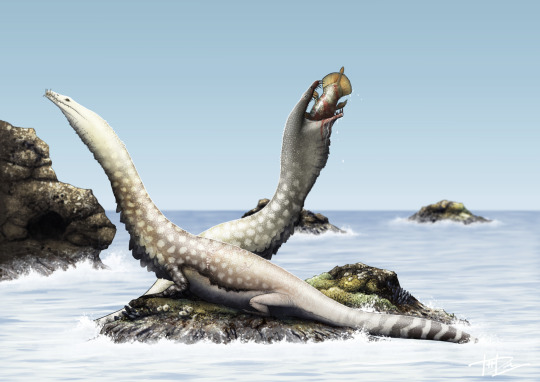
By Tas Dixon
Etymology: False Reptile
First Described By: Münster, 1834
Classification: Biota, Archaea, Proteoarchaeota, Asgardarchaeota, Eukaryota, Neokaryota, Scotokaryota, Opimoda, Podiata, Amorphea, Obazoa, Opisthokonta, Holozoa, Filozoa, Choanozoa, Animalia, Eumetazoa, Parahoxozoa, Bilateria, Nephrozoa, Deuterostomia, Chordata, Olfactores, Vertebrata, Craniata, Gnathostomata, Eugnathostomata, Osteichthyes, Sarcopterygii, Rhipidistia, Tetrapodomorpha, Eotetrapodiformes, Elpistostegalia, Stegocephalia, Tetrapoda, Reptiliomorpha, Amniota, Sauropsida, Eureptilia, Romeriida, Diapsida, Neodiapsida, Sauria, Archosauromorpha?, Archelosauria, Pantestudines, Sauropterygia, Eosauropterygia, Nothosauria, Nothosauridae, Nothosaurinae
Referred Species: N. mirabilis, N. cristatus, N. cymatosauroides, N. edingerae, N. giganteus, N. haasi, N. jagisteus, N. marchicus, N. mirabilis, N. tchernovi, N. yangjuanensis, N. zhangi
Time and Place: From 242 million years ago until 208 million years ago, from the Ladinian of the Middle Triassic through the earliest Rhaetian of the Late Triassic
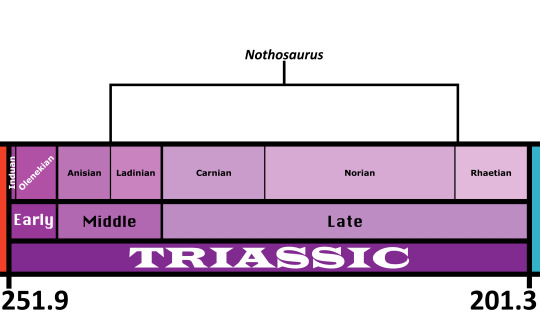
Nothosaurus is known from all over Eurasia and North Africa, to the point that it’s pointless to list all the locations. Just assume that if it’s the Mid or Late Triassic of the Tethys Sea, Nothosaurus is there.

Physical Description: Nothosaurus is an iconic Triassic marine reptile - to the point that we had to include it, or else we would have violated some sort of rule of paleontology. Nothosaurus was about 4 meters long on average, but could reach up to 7 meters in length. It had a long, streamlined body, with a long neck and a long tail. Its head was narrow and filled with long and pointed teeth which interlocked together when the mouth closed, forming a tight trap. Its forelimbs were longer than its hind limbs, and all of its hands and feet had webbing between the long toes. In a lot of ways, it looked extremely similar to later marine reptiles to which it was closely related, like the Plesiosaurs and Pliosaurs, just with hands instead of proper flippers - however, current evidence indicates that the Plesiosaurs and Pliosaurs evolved from an ancestor of both groups, and Nothosaurus is just a Triassic offshoot. It had capabilities for diving in the water, though it also was still adapted for life on the shore.
Diet: Nothosaurus primarily ate fish and other marine animals, including other marine reptiles.
Behavior: Nothosaurus was semi-aquatic, spending a lot of its time both in the ocean and on land. On the beaches and shores it would rest and sleep, and then turn to the ocean for most of its everyday life. Diving for food would have been most of its daily activities, going after juvenile reptiles and large fish in the water and diving in order to reach it. It probably would have paddled with its webbed feet, and undulated its body to some extent to help propel forward. It may have been at least somewhat social, living in groups and colonizing the shores together before going for group dives for food. Interestingly enough, Nothosaurus was basically like a reptilian seal, coming up to shore to rest and sit with its relatives. Whether or not they would have given birth to live young is uncertain; while their close relatives, the Plesiosaurs, did; they retained enough land adaptations to allow them to lay eggs on the shore. More research as to their physiology is needed in order to determine that aspect of their life history. Trackways have been attributed to Nothosaurus, which may show that they rowed their paddles on the sea bed to shake up small animals trapped underneath; this would have allowed Nothosaurus to capture the invertebrates between its long teeth and hold onto them so they could not escape.
Ecosystem: Nothosaurus lived throughout the early Tethys sea, and was a common feature in many communities throughout this growing body of water during the Middle and Late Triassic. It would have stuck to the coasts for the most part, but still ventured out into deep and open water. As such, it’s rather difficult to list all the different animals it lived alongside - it’s found in Bulgaria, China, France, Germany, Hungary, Israel, Italy, Jordan, the Netherlands, Poland, Saudi Arabia, Spain, and Switzerland. So just, assume that a marine creature from the Tethys during this time lived with Nothosaurus rather than not.
Other: Nothosaurus has been treated as, unfortunately, a wastebasket taxon - it was discovered early enough in the history of paleontology as a science that many similar animals were just dumped into this name without any specific studies done. So, determining the factual relationships from this mess is still being worked out; in fact, it seems that this genus is paraphyletic, with many close relatives of Nothosaurus being more closely related to some species than to others. So that’s fun!
Species Differences: The varying species of Nothosaurus tend to differ based on where and when they lived, rather than any particularly notable differences. There are some differences in size and limb proportions as well, but in general the differing species of Nothosaurus would have had very similar ecological roles.��
~ By Meig Dickson
Sources Under the Cut
Albers, P. C. H., and O. Rieppel. 2003. A new species of the sauropterygian genus Nothosaurus from the Lower Muschelkalk of Winterswijk, The Netherlands. Journal of Paleontology 77(4):738-744.
Albers, P. C. H. 2005. A new specimen of Nothosaurus marchicus with features that relate the taxon to Nothosaurus winterswijkensis. Vertebrate Palaeontology 3 (1): 1- 7.
Brotzen, F. 1956. Stratigraphical studies on the Triassic vertebrate fossils from Wadi Raman, Israel. Arkiv foer Mineralogi och Geologi 2(9):191-217.
Chrzastek, A. 2008. Vertebrate remains from the Lower Muschelkalk of Raciborowice Górne (North-Sudetic Basin, SW Poland). Geological Quarterly 52:225-238.
Diedrich, C. 2009. The vertebrates of the Anisian/Ladinian boundary (Middle Triassic) from Bissendorf (NW Germany) and their contribution to the anatomy, palaeoecology, and palaeobiogeography of the Germanic Basin reptiles. Palaeogeography, Palaeoclimatology, Palaeoecology 273 (1): 1 - 16.
d'Orbigny, A. 1849. Cours Élémentaire de Paléontologie et de Géologie Stratigraphiques [Elementary Course in Paleontology and Stratigraphic Geology] 1:1-299.
Haas, G 1980. Ein Nothosaurier-Schädel aus dem Muschelkalk des Wadi Ramon (Negev, Israel). Annalen des Naturhistorischen Museums in Wien 83:119-125.
Haines, Tim, and Paul Chambers. The Complete Guide to Prehistoric Life. Pg. 64. Canada: Firefly Books Ltd., 2006
Hinz, J. K., A. T. Matzke, and H.-U. Pfretzschner. 2019. A new nothosaur (Sauropterygia) from the Ladinian of Vellberg-Eschenau, southern Germany. Journal of Vertebrate Paleontology.
Jiang, W.; Maisch, M. W.; Hao, W.; Sun, Y.; Sun, Z. 2006. Nothosaurus yangjuanensis n. sp. (Reptilia, Sauropterygia, Nothosauridae) from the middle Anisian (Middle Triassic) of Guizhou, southwestern China. Neues Jahrbuch für Geologie und Paläontologie, Monatshefte. 5: 257–276.
Jiang, D.-Y., L. Schmitz, R. Motani, W.-C. Hao, and Y.-L. Sun. 2007. The mixosaurid ichthyosaur Phalarodon cf. P. fraasi from the Middle Triassic of Guizhou Province, China. Journal of Paleontology 81(3):602-605.
Klein, N. and P. C. H. Albers. 2009. A new species of the sauropsid reptile Nothosaurus from the Lower Muschelkalk of the western Germanic Basin, Winterswijk, The Netherlands. Acta Palaeontologica Polonica 54(4):589-598.
Lin, W.-B.; Jiang, D.-Y.; Rieppel, O.; Motani, R.; Ji, C.; Tintori, A.; Sun, Z.-Y.; Zhou, Min 2017. A new specimen of Lariosaurus xingyiensis (Reptilia, Sauropterygia) from the Ladinian (Middle Triassic) Zhuganpo Member, Falang Formation, Guizhou, China. Journal of Vertebrate Paleontology 37 (2): e1278703.
Liu, J. 2014. A gigantic nothosaur (Reptilia: Sauropterygia) from the Middle Triassic of SW China and its implications for the Triassic biotic recovery. Scientific Reports 4: 7142.
Lu, H., D.-Y. Jiang, R. Motani, P.-G. Ni, Z.-Y. Sun, A. Tintori, S.-Z. Xiao, M. Zhou, C. Ji and W.-F. Fu. 2018. Middle Triassic Xingyi Fauna: Showing turnover of marine reptiles from coastal to oceanic environments. Palaeoworld 27(1):107-116.
Münster, G. G. 1834. Preliminary news about some new reptiles in the shell limestone of Baiern. New Yearbook for Mineralogy, Geognosy, Geology and Petriology 1834 : 521-527.
Palmer, D. ed. 1999. The Marshall Illustrated Encyclopedia of Dinosaurs and Prehistoric Animals. London: Marshall Editions. p. 72.
Rieppel, O., and J.-M. Mazin. 1997. Speciation along rifting continental margins: a new nothosaur from the Negev (Israel). Comptes rendus de l'Académie des Sciences Série IIA, Sciences de la Terre et des planètes 326:991-997.
Rieppel, O. 2001. A new species of Nothosaurus (Reptilia: Sauropterygia) from the Upper Muschelkalk (Lower Ladinian) of southwestern Germany. Palaeontographica Abteilung A 263:137-161.
Sepkoski, J. J. 2002. A compendium of fossil marine animal genera. Bulletins of American Paleontology 363:1-560.
#nothosaurus#nothosaur#sauropterygian#triassic#triassic madness#triassic march madness#prehistoric life#paleontology
302 notes
·
View notes